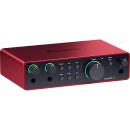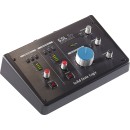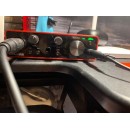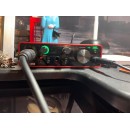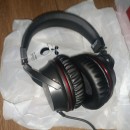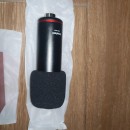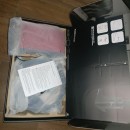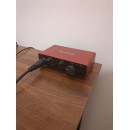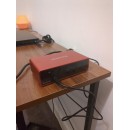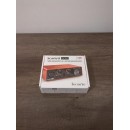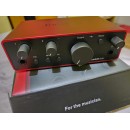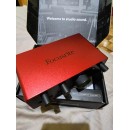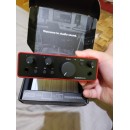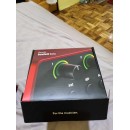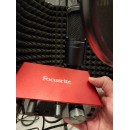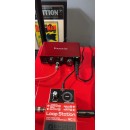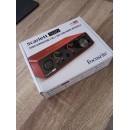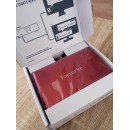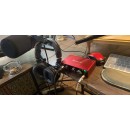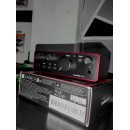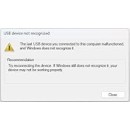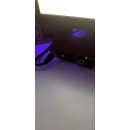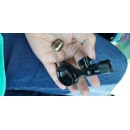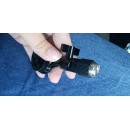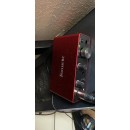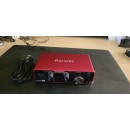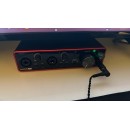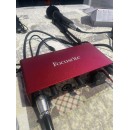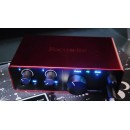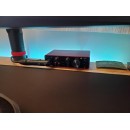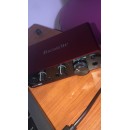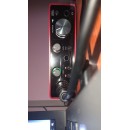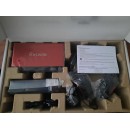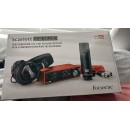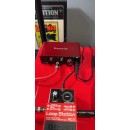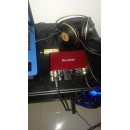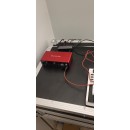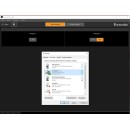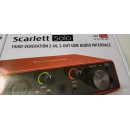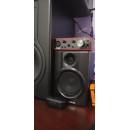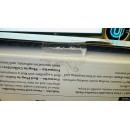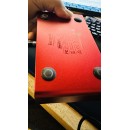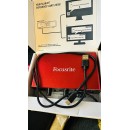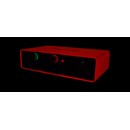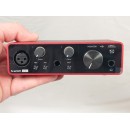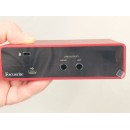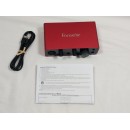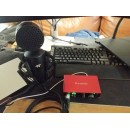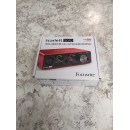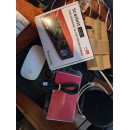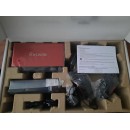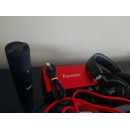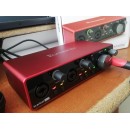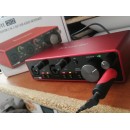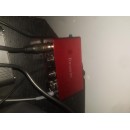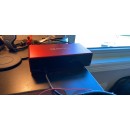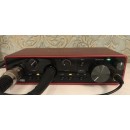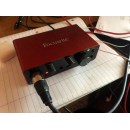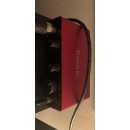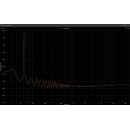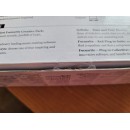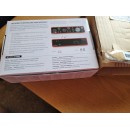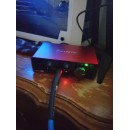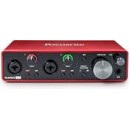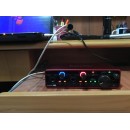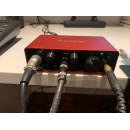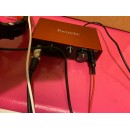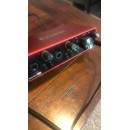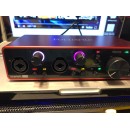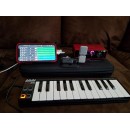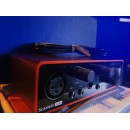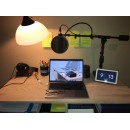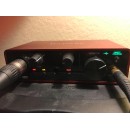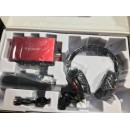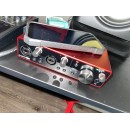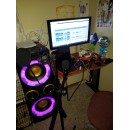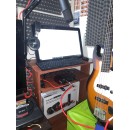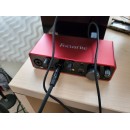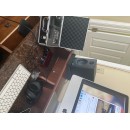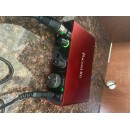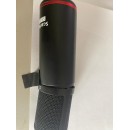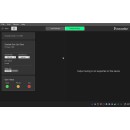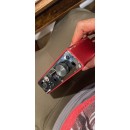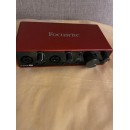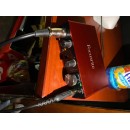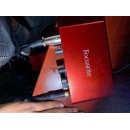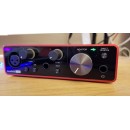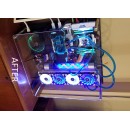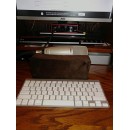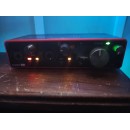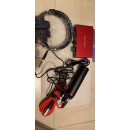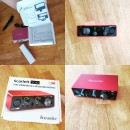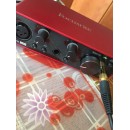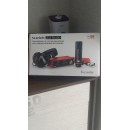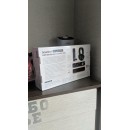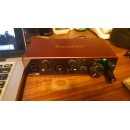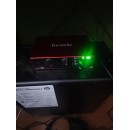SSL 2+ vs Focusrite Scarlett 2i2 (4th Gen): Detailed Audio Interface Comparison
The Focusrite Scarlett 2i2 (4th Gen) is celebrated for its user-friendly interface and high-quality preamps, making it a popular choice for home recording enthusiasts and small studios. This latest generation boasts an improved dynamic range and ultra-low latency, enhancing the overall recording experience. It features two combo inputs (XLR/TRS) with Focusrite’s renowned preamps, which now include an "Air" mode to emulate the sound of their classic ISA preamps. The 2i2 also offers 24-bit/192kHz conversion, ensuring pristine audio quality. The USB-C connectivity ensures fast data transfer and broad compatibility with modern devices. Additionally, the Scarlett 2i2 comes with a robust software bundle, including Ableton Live Lite and Pro Tools First, which provides users with all the tools needed for music production right out of the box.
On the other hand, the Solid State Logic SSL 2+ is designed to bring the legendary SSL sound to desktop recording. Known for their high-end studio consoles, SSL has integrated their expertise into this compact interface. The SSL 2+ features two SSL-designed analog microphone preamps with a 4K Legacy mode, which adds subtle harmonic distortion and high-frequency boost inspired by the SSL 4000 series consoles. It also offers 24-bit/192kHz conversion, ensuring high-fidelity recordings. Beyond the two combo inputs, the SSL 2+ includes additional outputs, MIDI I/O, and an extra headphone output, making it more versatile for various studio setups. The interface comes with a comprehensive software bundle, including SSL Native plug-ins, Avid Pro Tools First, and Ableton Live Lite, providing a strong foundation for recording, mixing, and mastering.
Both interfaces are housed in sturdy, portable enclosures, making them ideal for mobile recording scenarios. While the Focusrite Scarlett 2i2 emphasizes simplicity and ease of use, the SSL 2+ offers more extensive connectivity and the distinctive SSL sound. Your choice between the two would depend on whether you prioritize the straightforward, high-quality performance of the Scarlett or the additional features and classic sound character of the SSL 2+.
In-Depth Review and Comparison of SSL 2+ and Focusrite Scarlett 2i2 (4th Gen)
| User Rating Based on Analysis of Reviews | |
|---|---|
|
Show More |
| Pros: | |
|---|---|
|
|
| Cons: | |
|---|---|
|
|
| Find Best Price | Find Best Price |
| Key Specs | |
|---|---|
| Channels of I/O | |
| Analog: 2 Inputs / 2 Outputs at 192 kHz |
Analog: 2 Inputs / 4 Outputs at 192 kHz |
| Maximum Sampling Rate | |
| 192 kHz / 24-Bit | 192 kHz / 24-Bit |
| Number of Microphone Inputs | |
| 2 | 2 Preamps |
| Analog Audio I/O | |
| 2x XLR 3-Pin Balanced Mic Input 2x 1/4" TRS Balanced/Unbalanced Line/Hi-Z Input (Front Panel) 2x 1/4" TRS Balanced Monitor Output 1x 1/4" TRS Headphone Output (Front Panel) |
2x Combo XLR-1/4" TRS Balanced/Unbalanced Mic/Line/Hi-Z Input 2x 1/4" TRS Balanced Monitor Output 4x RCA TS Unbalanced Line Output 2x 1/4" TRS Unbalanced Headphone Output |
| Host Connection | |
| 1x USB-C | 1x USB-C |
| OS Compatibility | |
| macOS Windows |
macOS 10.11 macOS 10.12 macOS 10.13 macOS 10.14 macOS 10.15 Windows 8.1 Windows 10 |
| Power Requirements | |
| USB Bus Power, USB Power Adapter (Not Included) | USB Bus Power |
The Focusrite Scarlett 2i2 offers 2 channels of I/O, with a maximum sampling rate of 192 kHz at 24-bit resolution. It includes 2 microphone inputs, and its analog audio I/O consists of 2 XLR 3-pin balanced mic inputs, 2 1/4" TRS balanced/unbalanced line/Hi-Z inputs on the front panel, and 2 1/4" TRS balanced monitor outputs. Additionally, it has a 1/4" TRS headphone output on the front panel. The Scarlett 2i2 does not include digital audio I/O. It connects to the host via a single USB-C connection and is compatible with both macOS and Windows operating systems. Power is supplied through USB bus power, with an option for a USB power adapter which is not included.
Conversely, the Solid State Logic SSL 2+ provides 2 analog input channels and 4 output channels at the same maximum sampling rate of 192 kHz at 24-bit resolution. It also features 2 microphone preamps. The analog audio I/O includes 2 combo XLR-1/4" TRS balanced/unbalanced mic/line/Hi-Z inputs, 2 1/4" TRS balanced monitor outputs, 4 RCA TS unbalanced line outputs, and 2 1/4" TRS unbalanced headphone outputs. The SSL 2+ connects to the host via a single USB-C connection and supports macOS versions from 10.11 to 10.15 and Windows 8.1 and 10. It is powered solely through USB bus power.
In summary, while both interfaces offer high-quality audio recording with similar sampling rates and bit depths, the SSL 2+ provides additional output channels and more versatile connectivity options with its combo inputs and extra RCA outputs. The Scarlett 2i2, on the other hand, focuses on a streamlined set of inputs and outputs, which may be sufficient for users with simpler recording setups. Both interfaces are USB-C powered and compatible with major operating systems, ensuring wide usability.
| General | |
|---|---|
| Channels of I/O | |
| Analog: 2 Inputs / 2 Outputs at 192 kHz |
Analog: 2 Inputs / 4 Outputs at 192 kHz |
| Maximum Sampling Rate | |
| 192 kHz / 24-Bit | 192 kHz / 24-Bit |
| Number of Microphone Inputs | |
| 2 | 2 Preamps |
| Input Level Adjustment | |
| 2x Knob | 2x Knob |
| Expansion Slots | |
In terms of channels of input and output, the Focusrite Scarlett 2i2 offers 2 analog inputs and 2 analog outputs at a maximum sampling rate of 192 kHz. The Solid State Logic SSL 2+, on the other hand, provides 2 analog inputs and 4 analog outputs at the same maximum sampling rate of 192 kHz. This makes the SSL 2+ more versatile for users who need additional output channels for their audio projects.
Both interfaces support a maximum sampling rate of 192 kHz at 24-bit, ensuring high-quality audio recording and playback. They also feature 2 microphone inputs each, with the Scarlett 2i2 including 2 microphone inputs and the SSL 2+ specifying 2 preamps for its microphone inputs, which are known for their professional-grade quality.
When it comes to input level adjustment, both interfaces are equipped with 2 knobs, allowing users to easily control the input levels for their recordings. Neither interface includes built-in DSP or expansion slots, which keeps their designs straightforward and focused on core audio interface functionality.
Overall, while both the Focusrite Scarlett 2i2 and the Solid State Logic SSL 2+ offer high-resolution audio and similar basic features, the SSL 2+ distinguishes itself with additional output channels, which could be a deciding factor for users needing more comprehensive output routing options.
| Signal Processing | |
|---|---|
| Gain/Trim Range | |
| Mic/Line Inputs: Up to +69 dB Hi-Z Inputs: 62 dB |
Mic/Line/Hi-Z Inputs: Up to 62 dB |
In terms of gain/trim range, the Focusrite Scarlett 2i2 provides a more extensive range. The Mic/Line inputs can reach up to +69 dB, while the Hi-Z inputs offer up to 62 dB. This makes the Scarlett 2i2 particularly versatile for handling a variety of microphone sensitivities and instrument outputs, allowing for greater flexibility in recording different sound sources.
On the other hand, the Solid State Logic SSL 2+ offers a maximum gain/trim range of up to 62 dB across its Mic/Line/Hi-Z inputs. While slightly less than the Scarlett 2i2 in terms of maximum gain, this range is still quite robust and should be sufficient for most recording needs.
Notably, the SSL 2+ lacks a pad feature, which is sometimes used to prevent signal overload by reducing the input level. The absence of this feature might be a consideration for those who frequently record very loud sources. Additionally, the SSL 2+ does not include a high-pass filter, which can be useful for eliminating low-frequency noise or rumble from recordings. The absence of solo/mute functionality might also be a limitation for users who need these controls for precise monitoring and mixing.
Overall, the Focusrite Scarlett 2i2 (4th Generation) offers a higher gain range and potentially greater flexibility for various recording scenarios, while the SSL 2+ provides solid performance but lacks some additional features like a pad, high-pass filter, and solo/mute functions. Depending on specific recording needs and preferences, either interface could be a suitable choice.
| Connectivity | |
|---|---|
| Analog Audio I/O | |
| 2x XLR 3-Pin Balanced Mic Input 2x 1/4" TRS Balanced/Unbalanced Line/Hi-Z Input (Front Panel) 2x 1/4" TRS Balanced Monitor Output 1x 1/4" TRS Headphone Output (Front Panel) |
2x Combo XLR-1/4" TRS Balanced/Unbalanced Mic/Line/Hi-Z Input 2x 1/4" TRS Balanced Monitor Output 4x RCA TS Unbalanced Line Output 2x 1/4" TRS Unbalanced Headphone Output |
| Phantom Power | |
| 48 V, Selectable On/Off | 48 V, Selectable On/Off (Selectable on Individual Inputs) |
| Digital Audio I/O | |
| Host Connection | |
| 1x USB-C | 1x USB-C |
| Host Connection Protocol | |
| USB 2.0 | USB 2.0 |
| USB (Non-Host) | |
| 1x USB-C (Power Input) | |
| Sync I/O | |
| Network I/O | |
| MIDI I/O | |
|
1x DIN 5-Pin Input 1x DIN 5-Pin Output |
|
In terms of Analog Audio I/O, the Focusrite Scarlett 2i2 provides 2x XLR 3-Pin Balanced Mic Inputs and 2x 1/4" TRS Balanced/Unbalanced Line/Hi-Z Inputs on the front panel, along with 2x 1/4" TRS Balanced Monitor Outputs and a single 1/4" TRS Headphone Output on the front panel. On the other hand, the SSL 2+ features 2x Combo XLR-1/4" TRS Balanced/Unbalanced Mic/Line/Hi-Z Inputs, 2x 1/4" TRS Balanced Monitor Outputs, 4x RCA TS Unbalanced Line Outputs, and 2x 1/4" TRS Unbalanced Headphone Outputs. The SSL 2+ provides more output options, including RCA outputs, which can be advantageous for connecting to different types of equipment.
Both interfaces offer 48V phantom power for their mic inputs, but the SSL 2+ allows for selectable phantom power on individual inputs, giving more flexibility in mixed microphone setups. The Focusrite Scarlett 2i2 does not provide this per-channel control, offering a single switch to enable or disable phantom power for both mic inputs simultaneously.
Neither model includes Digital Audio I/O, Sync I/O, or Network I/O capabilities. However, the SSL 2+ has a significant advantage with its inclusion of MIDI I/O, featuring 1x DIN 5-Pin Input and 1x DIN 5-Pin Output, which allows for better integration with MIDI controllers and other MIDI-capable hardware. The Focusrite Scarlett 2i2 lacks any MIDI I/O capability, which might be a dealbreaker for users needing this functionality.
For host connection, both interfaces utilize a single USB-C port with a USB 2.0 protocol, ensuring compatibility with modern computers. The Focusrite Scarlett 2i2 also includes an additional USB-C port dedicated to power input, which can be useful in scenarios where additional power stability is required.
In summary, while both the Focusrite Scarlett 2i2 and the SSL 2+ offer robust and high-quality audio interface solutions, the SSL 2+ stands out with its additional output options, individual phantom power control per input, and the inclusion of MIDI I/O. The Focusrite Scarlett 2i2, however, may appeal to those looking for a more straightforward setup without the need for MIDI capabilities or multiple output types.
| Performance | |
|---|---|
| Frequency Response | |
| XLR Mic Inputs: 20 Hz to 20 kHz ±0.06 dB 1/4" Line Inputs: 20 Hz to 20 kHz 0.05 dB 1/4" Hi-Z Inputs: 20 Hz to 20 kHz 0.15 dB |
Line, Hi-Z Inputs: 20 Hz to 20 kHz ±0.05 dB Mic Inputs: 20 Hz to 20 kHz ±0.1 dB Line, Headphone, Monitor Outputs: 20 Hz to 20 kHz ±0.05 dB |
| Maximum Input Level | |
| XLR Mic: 16 dBu 1/4" Line: 22 dBu 1/4" Hi-Z: 12 dBu |
Mic Inputs: +5.5 dBu Line Inputs: +24 dBu Hi-Z Inputs: +15 dBu |
| Maximum Output Level | |
| 1/4" Line: +16 dBu |
1/4" Monitor Outputs: +12.5 dBu RCA Line Outputs: +6.5 dBu Headphone Outputs: +10 dBu |
| Impedance | |
| XLR Mic Inputs: 3 Kilohms 1/4" Line Inputs: 60 Kilohms 1/4" Hi-Z Inputs: 1 Megohms 1/4" Line Outputs: 100 Ohms 1/4" Headphone Outputs: < 50 Ohm |
Mic Inputs: 1.2 Kilohms Line Inputs: 10 Kilohms Hi-Z Inputs: 1 Megohm Monitor Outputs: 1 Ohm RCA Line Outputs: < 1 Ohm Headphone Outputs: 10 Ohms |
| Dynamic Range | |
| XLR Mic Inputs: 116 dBA 1/4" Line Inputs: 115.2 dBA 1/4" Hi-Z Inputs: 113 dBA 1/4" Line Outputs: 120 dB 1/4" Headphone: 112 dB (at 33 Ohms) 115 dB (at 300 Ohms) Digital A/D Converters: 120 dB Digital D/A Converters: 130 dBA |
Mic/Line/Hi-Z Inputs: 110.5 dB (A-Weighted) Monitor Outputs: 112 dB (A-Weighted) RCA Line Outputs: 110 dB Headphone Outputs: 111 dB (A-Weighted) |
| THD+N | |
| XLR Mic Inputs: -100 dB (at 8 dB Gain) 1/4" Line Inputs: -100 dB (at 8 dB Gain) 1/4" Hi-Z Inputs: -80 dB (at Minimum Gain) 1/4" Line Outputs: -109 dB 1/4" Headphone Outputs: -99 dB (at 33 Ohms) -108 dB (at 300 Ohms) Digital A/D Converters: -110 dB Digital D/A Converters: -115 dB |
Mic/Line/Hi-Z Inputs: < 0.005% (at -1 dBFS) Monitor Outputs: < 0.002% (at -1 dBFS) RCA Line Outputs: < 0.0025% (at -1 dBFS) Headphone Outputs: < 0.002% (at -1 dBFS) |
| EIN | |
| XLR Mic Inputs: -127 dBu A-Weighted |
Mic Inputs: -130.5 dBu A-Weighted (150-Ohm Source) |
Starting with the frequency response, the Focusrite Scarlett 2i2 provides a very flat response across all input types: XLR mic inputs offer a range of 20 Hz to 20 kHz ±0.06 dB, 1/4" line inputs at 20 Hz to 20 kHz ±0.05 dB, and 1/4" Hi-Z inputs at 20 Hz to 20 kHz ±0.15 dB. In comparison, the SSL 2+ offers a similar range but with slight variations: line and Hi-Z inputs at 20 Hz to 20 kHz ±0.05 dB, mic inputs at 20 Hz to 20 kHz ±0.1 dB, and line, headphone, and monitor outputs at 20 Hz to 20 kHz ±0.05 dB.
Regarding maximum input levels, the Scarlett 2i2 accommodates up to 16 dBu on XLR mic inputs, 22 dBu on 1/4" line inputs, and 12 dBu on 1/4" Hi-Z inputs. The SSL 2+ has higher capabilities with mic inputs supporting up to +5.5 dBu, line inputs at +24 dBu, and Hi-Z inputs at +15 dBu.
When it comes to maximum output levels, the Scarlett 2i2 provides up to +16 dBu on 1/4" line outputs and delivers 32 mW into 33 Ohms and 22 mW into 300 Ohms for headphone outputs. The SSL 2+ offers lower output levels with +12.5 dBu for monitor outputs, +6.5 dBu for RCA line outputs, and +10 dBu for headphone outputs.
The impedance specifications show that the Scarlett 2i2 has XLR mic inputs at 3 Kilohms, 1/4" line inputs at 60 Kilohms, 1/4" Hi-Z inputs at 1 Megohms, 1/4" line outputs at 100 Ohms, and 1/4" headphone outputs at less than 50 Ohms. The SSL 2+ features mic inputs at 1.2 Kilohms, line inputs at 10 Kilohms, Hi-Z inputs at 1 Megohm, monitor outputs at 1 Ohm, RCA line outputs at less than 1 Ohm, and headphone outputs at 10 Ohms.
In terms of dynamic range, the Scarlett 2i2 excels with XLR mic inputs at 116 dBA, 1/4" line inputs at 115.2 dBA, 1/4" Hi-Z inputs at 113 dBA, line outputs at 120 dB, and headphone outputs at 112 dB (33 Ohms) and 115 dB (300 Ohms). Its digital A/D and D/A converters offer 120 dB and 130 dBA, respectively. The SSL 2+ offers a slightly lower dynamic range: mic/line/Hi-Z inputs at 110.5 dB (A-Weighted), monitor outputs at 112 dB, RCA line outputs at 110 dB, and headphone outputs at 111 dB (A-Weighted).
For THD+N, the Scarlett 2i2 shows -100 dB for XLR mic and 1/4" line inputs, -80 dB for 1/4" Hi-Z inputs, -109 dB for 1/4" line outputs, and -99 dB (33 Ohms) and -108 dB (300 Ohms) for headphone outputs. Its digital converters have -110 dB for A/D and -115 dB for D/A. The SSL 2+ has lower THD+N values: less than 0.005% for mic/line/Hi-Z inputs, less than 0.002% for monitor outputs, less than 0.0025% for RCA line outputs, and less than 0.002% for headphone outputs.
Finally, the Equivalent Input Noise (EIN) for the Scarlett 2i2 is -127 dBu A-Weighted for XLR mic inputs, whereas the SSL 2+ offers a slightly better performance at -130.5 dBu A-Weighted for mic inputs with a 150-Ohm source.
| Digital Audio | |
|---|---|
| Sample Rates | |
| 44.1 / 48 / 88.2 / 96 / 176.4 / 192 kHz | Up to 192 kHz |
| Bit Depths | |
| 24-Bit | Up to 24-Bit |
| Sync Sources | |
| Internal | Internal |
The Focusrite Scarlett 2i2 (4th Generation) supports sample rates of 44.1, 48, 88.2, 96, 176.4, and 192 kHz with a bit depth of 24-bit. It uses an internal sync source for its operations. This extensive range of sample rates provides flexibility for various recording and production needs, from basic recordings to high-resolution audio.
On the other hand, the Solid State Logic SSL 2+ supports sample rates up to 192 kHz and bit depths up to 24-bit, similar to the Scarlett 2i2. However, it does not feature sample rate conversion. The SSL 2+ boasts a latency of less than 1 ms at 48 kHz from input to output, which is particularly advantageous for real-time monitoring and recording. Like the Scarlett 2i2, the SSL 2+ also uses an internal sync source.
Both interfaces are designed to deliver professional-grade audio fidelity, but the SSL 2+ offers a noteworthy advantage in terms of low latency, which can be crucial for certain recording and production environments. The Focusrite Scarlett 2i2's wide range of sample rates might be more appealing for users who need versatility in their recording settings.
| Audio Storage & Playback |
|---|
| Compatibility | |
|---|---|
| OS Compatibility | |
| macOS Windows |
macOS 10.11 macOS 10.12 macOS 10.13 macOS 10.14 macOS 10.15 Windows 8.1 Windows 10 |
The Focusrite Scarlett 2i2 is compatible with both macOS and Windows operating systems, making it versatile for users across different platforms. Additionally, it supports a mobile app compatible with iPadOS, which is a significant advantage for users who prefer or need to integrate their iPad into their audio production workflow.
On the other hand, the Solid State Logic SSL 2+ offers compatibility with a broader range of specific macOS versions (10.11 through 10.15) and Windows versions (8.1 and 10). However, it does not offer compatibility with mobile devices, which could be a limitation for users looking to incorporate tablets or smartphones into their setup.
The SSL 2+ also requires an available USB 2.0 port and includes a USB cable, ensuring that users have the necessary hardware to get started right away. Additionally, an internet connection is required for registration and software/driver download, which is an important consideration for users needing to set up the interface.
In summary, the Focusrite Scarlett 2i2 provides broader operating system compatibility and the added benefit of mobile app compatibility with iPadOS, making it suitable for users looking for flexibility and integration with mobile devices. The SSL 2+, while offering more specific OS compatibility and necessary hardware inclusions, does not support mobile devices, which may limit its appeal to users seeking mobile integration.
| Power | |
|---|---|
| Power Requirements | |
| USB Bus Power, USB Power Adapter (Not Included) | USB Bus Power |
However, the Scarlett 2i2 (4th Gen) also provides the option to use a USB power adapter, which is not included with the device. This flexibility can be beneficial in scenarios where a more stable power source is required, or when the USB bus power might not suffice due to other connected peripherals. The Scarlett 2i2 requires an AC/DC power adapter that supplies 5 VDC at 900 mA and has a power consumption of 4.5 watts.
In contrast, the SSL 2+ relies solely on USB bus power, streamlining its setup by eliminating the need for any additional power adapters. This can be an advantage for users who prioritize simplicity and minimal cable clutter. However, it also means that the SSL 2+'s performance is entirely dependent on the power it can draw from the USB connection, which could be a consideration in power-constrained environments.
In summary, while both interfaces support USB bus power, the Focusrite Scarlett 2i2 (4th Gen) offers an additional option for external power via a USB power adapter, which can enhance its versatility under varying power conditions. The SSL 2+, on the other hand, keeps things straightforward with exclusive USB bus power dependency, which may appeal to users seeking a more streamlined setup.
| Physical | |
|---|---|
| Dimensions | |
| 7.1 x 4.6 x 1.87" / 18 x 11.7 x 4.75 cm | 9.2 x 6.2 x 2.7" / 23.4 x 15.7 x 6.9 cm |
| Weight | |
| 1.3 lb / 595.0 g | 2.0 lb / 0.9 kg |
In terms of additional features, the Solid State Logic SSL 2+ includes a Kensington Security Slot for anti-theft protection. It also specifies an operating temperature range of 33 to 104°F (1 to 40°C) and a storage temperature range of -4 to 122°F (-20 to 50°C). The Focusrite Scarlett 2i2 does not list similar anti-theft or temperature range features.
In summary, the Focusrite Scarlett 2i2 is more compact and lighter compared to the Solid State Logic SSL 2+. However, the SSL 2+ offers additional security and environmental durability features, making it potentially more suitable for varied working conditions.
| Packaging Info | |
|---|---|
| Package Weight | |
| 1.9 lb | 2.61 lb |
| Box Dimensions (LxWxH) | |
| 8.2 x 7 x 2.6" | 10.9 x 7.9 x 4.1" |
Comparing the physical attributes, the Focusrite Scarlett 2i2 is more compact and lightweight, making it potentially more portable and easier to fit into smaller studio spaces. The SSL 2+, while heavier and larger, might offer more robust build quality or additional features that justify its larger size and weight.
Each interface's dimensions and weight can affect their portability and ease of use in different environments, so potential buyers should consider these factors based on their specific needs and preferences.
| Customer Images | |
|---|---|
| Videos | |
|---|---|
|
|
|
